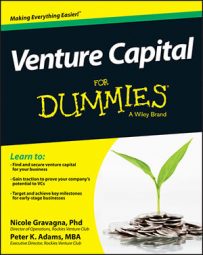Venture capital investors want to be involved in markets that will support the kind of growth they need to be successful. In making an assessment about whether your market is big enough, VCs make a distinction between the size of the market as a whole and the size of the addressable market.
The addressable market is the part of the market that your company uniquely serves. Your ability to understand this difference will make a huge difference in the credibility you have with your VC.
One reason that VCs want to be in only big markets is because they need many options for a successful exit. If your market is too small to justify going public (usually a threshold of $100 million or more in annual revenues) or doesn’t have a significant number of large players with resources to acquire your company, then the VC doesn’t have good exit options, and he won’t be interested. VCs make big risks and need big payoffs to make it worthwhile.
Defining your addressable market
If your company makes a great new kind of ice cream bar that is exceptionally popular in your test markets, you might say that your market size is based on the $10 billion annual ice cream sales data. But that assertion would be inaccurate, because ice cream novelties (individually wrapped ice cream bars and popsicles) represent only 20 percent of the total ice cream market.
More accurately, you could say that your market size is $2 billion per year. You might even reduce that further by acknowledging that you’ll distribute only regionally, as is the trend in the ice cream market. With those parameters in mind, your addressable market is reduced to $500 million per year.
If your strategy is to pursue the market through grocery and convenience store sales, your final numbers would need to take into account that the take-home market for ice cream is 67 percent of the market, making your addressable market only $335 million — a long way from your initial claim of $10 billion!
Why do you want to claim a smaller addressable market instead of the whole market? Because VCs will do this reductionist math in their heads anyway. By giving them accurate numbers up front, you demonstrate your in-depth knowledge of your industry, your honesty, and your specific strategy to capture a piece of it.
Gaining traction in the big market
In addition to determining the size of your addressable market, venture capitalists look for companies that have traction, the ability to capture a big portion of a big market. Your ability to demonstrate traction in selling into a big market is every bit as important as being in a big market.
Big markets are competitive and difficult to break into unless you have an unfair advantage or novel approach. (Big markets often require huge investments to enter and may have extraordinary price pressures that require huge volumes in order to compete. These are often barriers that start-ups cannot overcome.)
Traction is defined in many ways. Traction in a tight-knit field may mean convincing a thought-leader to join your advisory board. Traction in the market means convincing consumers to pay for your product. Traction in a regulatory pathway means that you have gotten through the initial phases of FDA approval.
The more traction your company has, the farther you are from simply having an idea, and the closer you come to having a profitable and growing business. Simply stated, the best way to measure traction and market acceptance is your revenue.

